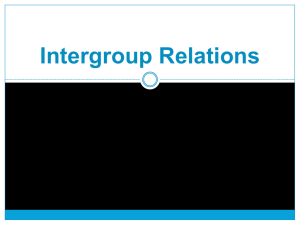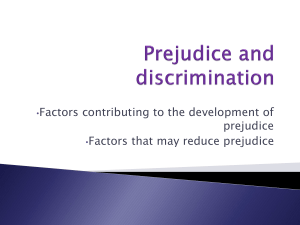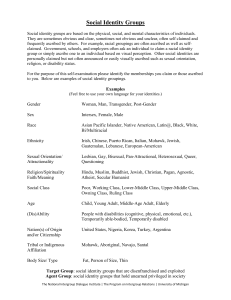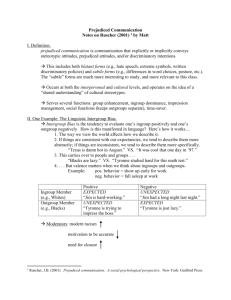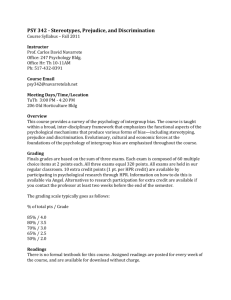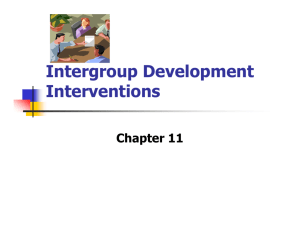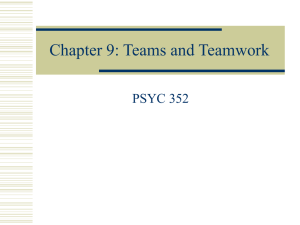Lecture 12
advertisement
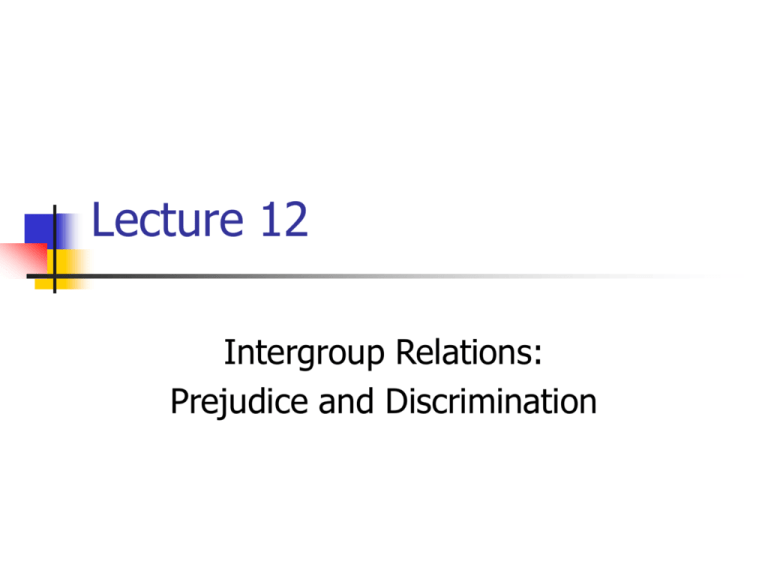
Lecture 12 Intergroup Relations: Prejudice and Discrimination Outline Introduction What is Prejudice? Theories of Intergroup Relations Authoritarian Personality Theory Realistic Conflict Theory Social Identity Theory Reducing Prejudice and Discrimination The Contact Hypothesis Common Ingroup Identity Model Introduction Ingroup: The social group to which an individual perceives herself or himself as belonging (“us”). Outgroup: Any group other than the one to which individuals perceive themselves as belonging (“them”). What is prejudice? Prejudice is a positive or negative attitude towards individuals based upon their membership in a particular social group. What is Prejudice? 3 components of a prejudiced attitude (A) Affective (B) Behavioral Evaluative/emotional aspect Discrimination: positive or negative behavior directed toward the persons or groups who are targets of prejudice (C) Cognitive Stereotypes: A cognitive framework (i.e., schema) to the effect that all members of a specific social group share certain characteristics. Theories of Intergroup Relations, cont. Authoritarian Personality Theory The authoritarian personality can be described in terms of 3 components 1. Authoritarian submission 2. Authoritarian aggression A high degree of submission to authorities who are perceived to be established and legitimate in the society in which one lives. 3. A general aggressiveness, directed against various persons, that is perceived to be sanctioned by established authorities. Conventionalism A high degree of adherence to the social conventions that are perceived to be endorsed by society and its established authorities. Theories of Intergroup Relations, cont. Authoritarian Personality Theory, cont. Scape-goating A response to frustration whereby the individual displaces aggression onto a socially disapproved outgroup. Theories of Intergroup Relations, cont. Realistic Conflict Theory (Sherif) Development of Group Culture Group Formation Tasks require intragroup cooperation Biased perceptions Intergroup Conflict Intergroup competition for scarce resources Harmonious intergroup attitudes Intergroup Cooperation Introduce superordinate goal Theories of Intergroup Relations, cont. Social Identity Theory (Tajfel, 1978) Social categorization Social identity Social comparison Psychological group distinctiveness Theories of Intergroup Relations, cont. Social Identity Theory, cont. Social comparison The cognitive tendency to divide the social world into categories (i.e., social groups). This categorical differentiation has the effect of sharpening the distinctions between the categories and blurs the differences within them. Theories of Intergroup Relations, cont. Social Identity Theory Social identity That part of the individual’s self-concept which derives from knowledge of his or her membership in a social group, together with the value and emotional significance associated to that membership. Theories of Intergroup Relations, cont. Social Identity Theory, cont. Social comparison The process through which characteristics of the ingroup are compared to those of the outgroup. Theories of Intergroup Relations, cont. Social Identity Theory, cont. Psychological Group Distinctiveness The state desired by individuals in which the ingroup has an identity that is perceived by the group members as being both distinct and positive vis-à-vis relevant comparison groups. Reducing Prejudice The Contact Hypothesis (Amir, 1969) Cooperative Interdependence Equal Status Acquaintance Potential Institutional Support Prejudice Reduction Reducing Prejudice, cont. Common Ingroup Identity Model Individuals in different groups who view themselves as members of a single social entity will experience more positive contacts between themselves and intergroup bias will be reduced. Recategorization Shifts in the boundary between an individual’s ingroup and various outgroups cause persons formerly viewed as outgroup members now to be seen as belonging to the ingroup Reducing Prejudice, cont. Dissociation Model (Devine, 1989) Based on a conflict between stereo-typed responses and personal beliefs Automatic Processes (stereotyped-response) Involve the unintentional (spontaneous) activation of previously developed associations in memory that have been established through a history of repeated activation. Controlled Processes (personal beliefs) Refers to the intentional activation of information stored in memory. More flexible than automatic processes, but they can be initiated only with active attention and not under conditions in which one’s cognitive capacity is limited
